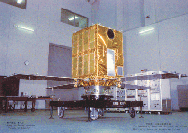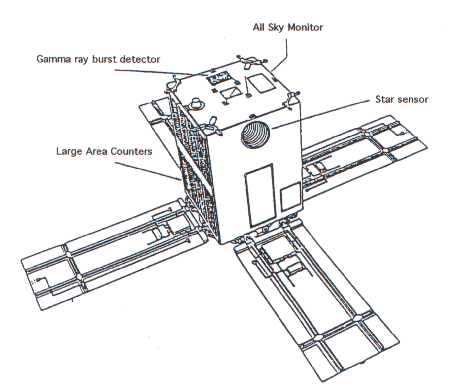|
|

Ginga
The third Japanese X-ray astronomy satellite, Ginga, was
launched on a Mu-3SII-3 rocket from Kagoshima Space Center
on 5 Feburary 1987.
The
payload consisted of three instruments: a Large Area
Proportional Counter (LAC 1.5-37 keV), developed in collaboration with the UK,
an All-Sky Monitor (ASM 1-20 keV), and a Gamma-ray Burst Detector (GBD 1.5-500
keV), developed in collaboration with the USA. The satellite was placed into
an orbit with perigee of 510 km and apogee of 670 km and an inclination of
31°. Its orbital period was ~96 minutes. Ginga was approximately
1000 x 1000 x 1550 mm in size. It weighed about 420 kg. The Ginga
configuration is shown in the Figure below. The spacecraft was three-axis
stabilised by a momentum wheel and a four-gyro inertial reference system,
calibrated by two CCD star trackers. The spacecraft pointing manoeuvers were
carried out with three-axis magnetic torquers.

The time required to move the Z-axis was slow and observation lengths of less
than a day were not practical. Manoevers that rotated around the Z-axis were
made quicker, but this required a suitable alignment of the sources carried out
with three-axis torquers. The pointing accuracy was better than six arc
minutes, while the attitude reconstruction had an accuracy of approximately
one arc minute. The solar panels had to be held within 45 degrees of the sun
direction in order to satisfy power constraints. This constraint limited the
portion of the sky observable by the LAC at any given time of the year, to
within a band of +/- 45 degrees wide along a great circle perpendicular to the
sun vector. Data were transmitted at three different bit rates: 16384 bps
(high rate), 2048 bps (medium rate) and 512 bps (low rate). An on-board
bubble-memory data recorder with a capacity of 41.9 Mbits could store data for
42.7 minutes at the high data rate, 5.68 hours at the medium rate, and 22.73
hours at the low data rate. The stored date were played back during a ground
contact at either 65,536 bps or 131,072 bps.
The satellite operated till November 1991.
The Ginga observing program was open to scientists from Japan, the UK, the USA,
and a number of European countries. During the mission lifetime Ginga observed
about 350 targets including all classes of X-ray sources.
The Large Area Proportional Counter (LAC) was the main scientific instrument
aboard Ginga. It was designed and built under a Japan-UK collaboration (ISAS,
U. Tokyo, Nagoya U., U. Leicester, Rutherford Appleton Lab). It consisted of
eight multicell proportional counters for a total effective area of 4000
cm2.
The field of view of the LAC was 0.8 x 1.7 degrees full width at half-maximum
(FWHM), with the longer side parallel to the Z-axis, and was defined by
honeycomb collimators made of thin stainless steel sheets. The counters were
filled with a gas mixture of 70 percent argon, 25 percent xenon, and 5
percent carbon dioxide to a total pressure of 2 atmospheres at 20 degrees
Celsius. The effective energy range over which the detection efficiency was
more than 10 percent was approximately 1.5-30 keV. The energy resolution was
better than 20 percent FWHM at 5.9 keV.
Accepted X-ray events were pulse-height analysed into a maximum of 48 pulse
height channels. There were four modes of observation, listed in the Table
below. The time resolution was mode-dependent. The highest time resolution
available was 0.98 milliseconds, achieved at the expense of spectral
information. The detection limit for the LAC was approximately 0.1 milliCrab,
or 2 x 10-12 ergs/cm2-sec in the range 2-10 keV.
| Mode |
No. of Pulse Height Ch. |
Bit Rate |
No. of Output Signals |
| High |
Medium |
Low |
| 1 |
48 |
0.5 s |
4.0 s |
16.0 s |
8, each of
8 counters |
| 2 |
48 |
62.5 ms |
0.5 s |
2.0 s |
2, sums of
4 counters |
| 3 |
12 |
7.8 ms |
62.5 ms |
0.25 s |
1, sum of all
8 counters |
| 4 |
2 |
H 1.9 ms
L 0.98 ms |
15.6 ms
7.8 ms |
62.5 ms
31.3 ms |
2, sums of
4 counters |
The All-Sky Monitor (ASM) consisted of 2 identical gas proportional counters,
and was sensitive to 1-20 keV. Each counter was equipped with a collimator
which had 3 different fields of view (1° x 45° FWHM). The aim of
the ASM was to create an all-sky survey every 1-2 days to look for transient
events (to alert the LAC) and to collect a long-term record for X-ray sources.
The purpose of the Gamma-Ray Burst Detector (GBD) was to detect gamma-ray
bursts in the energy range 1-500 keV with a time resolution of 31.3 msec and
high-energy resolution. It was comprised of two sensors: a proportional
counter (PC) and a scintillation spectrometer (SC). The GBD could also
operate as a radiation belt monitor for high particle backgrounds which could
harm the other 2 experiments.
[Ginga Home]
[About Ginga]
[Archive]
[Software]
[Gallery]
[Publications]
Page authors: Lorella Angelini Jesse Allen
HEASARC Home |
Observatories |
Archive |
Calibration |
Software |
Tools |
Students/Teachers/Public
Last modified: Tuesday, 21-Apr-2020 10:28:35 EDT
|



